- Economy
- Posted
Sustainability or bust
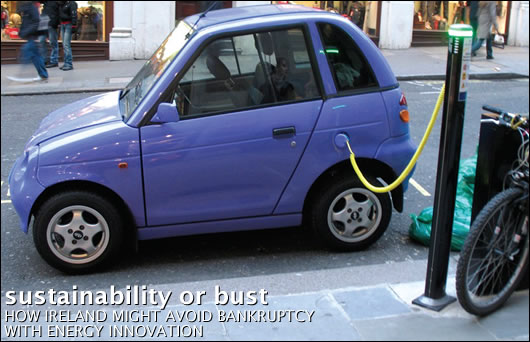
As if the implications of the unfolding global financial crisis weren’t bad enough, the Irish economy must also contend with the consequences of a banking system exposed to unprecedented property-related debts. Reflecting on the ongoing crisis, Richard Douthwaite explains why investment in local energy innovation may prove the key to improving Ireland’s economic health
Unless urgent action is taken, the Irish banks will suffer massive losses in the next two or three years. Because these losses are now the responsibility of the state as a result of the guarantees the banks have been given, Ireland may itself go bust. It may have to default on its obligations.
I wrote those sentences with care because they sound so extreme, but that is the situation. Here's how it came about.
During the property boom, all the Irish banks borrowed from banks elsewhere in the world so as to be able to lend to their customers. Most of this money was borrowed for a few weeks or months but was lent out for years or, in the case of mortgages, for decades. This was in contravention of the traditional bankers' cardinal rule, never to borrow short to lend long. It was the Northern Rock business model and among those who adopted it was Anglo Irish Bank.
If the banks' world had continued as usual, they would have gotten away with it. They would have been able to repay their short-term loans by taking on new ones for similar short periods. But two things changed their world beyond recognition. One was the global credit crunch, the other was the bursting of the Irish property bubble.
The effect of the credit crunch was to make overseas banks much more cautious about where, and for how long, they lent their funds. They knew that Anglo had specialised in lending to developers in Ireland and Britain and that the collapse in the property market in both countries meant that a lot of its loans might not be repaid. Accordingly, when it went looking for more short-term money, they politely refused.
Although Anglo announced a 17 per cent increase in profits in May and a ratings agency reported “consistently strong profitability, good asset quality, an extremely low cost/income ratio, diversified funding and stable margins” in August, some big private depositors began taking their money out.
Every night, a bank has to balance what it has taken in during the day with what it has paid out. If it has paid out more than it took in, it needs to borrow the shortfall from another bank overnight. On the other hand, if it has taken in more than it paid, it can lend the surplus to a bank in deficit.
If a bank persistently requires overnight money in increasingly large amounts, the other banks know that it has problems and will decline to lend. Anglo's problems came to a head on Monday, September 29. It had to make a substantial repayment to a German bank the following day but had been unable to find a bank or private depositors prepared to lend it the money to do so. This was in spite of its announcing, only a week earlier, that it was offering the highest rates of interest in the country for sums of up to e100,000. Higher than normal interest rates are a sure sign that a bank is risky or in trouble.
Although the Central Bank and the Financial Regulator had been monitoring Anglo's health closely, AIB and Bank of Ireland requested a meeting with the government that night because they were under pressure too as graph 1 shows. The meeting was told that Anglo would not open the following day unless something was done. The bankers added that the Irish Nationwide Building Society, another institution which had lent a lot to developers, was likely to crash too, and that the knock-on effects of both going down would cause acute problems for the survivors, AIB, Bank of Ireland, EBS and Irish Permanent.
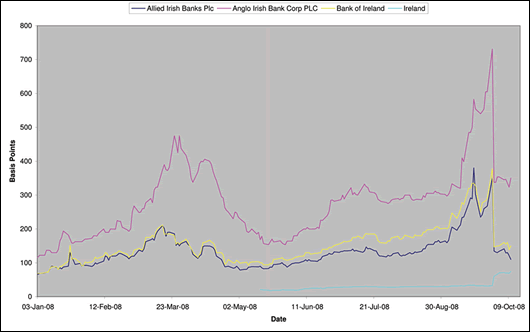
Graph 1: The cost of insuring loans to Irish banks rose to a peak in September and was then sharply reduced by the state guarantee. Anglo Irish Bank was seen by the market to be particularly risky. Lending to the Irish government was seen as much safer, but the cost of insuring against its default is now double what it was before the guarantees were given.
Source: CMA DataVision
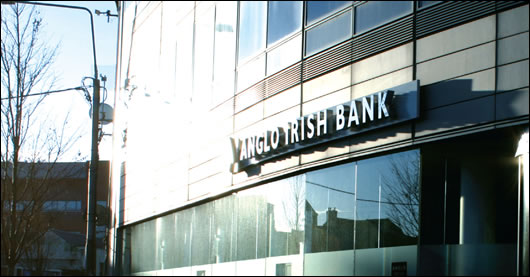
Anglo Irish Bank, whose doors could have shut if the Government had not stepped in, after other banks stopped loaning them money
The risk that the whole Irish financial sector would collapse left the government with no alternative but to guarantee all six institutions' debt. The guarantee was announced just before 7am on Tuesday, September 30, a day that will go down as a turning point in Irish history. This is because, by giving the guarantees, the government converted private debts which would have been written down in value had the banks been allowed to collapse into public ones which can neither be written down nor written off unless the state itself defaults. Such defaults are rare in advanced countries although during the depression in the 1930s, Britain and France both defaulted because the repayment burden on their people had become too great. Russia defaulted in 1998 in the wake of the collapse of the USSR, Turkey did so in 2001, and the biggest sovereign default in history occurred when Argentina defaulted on $141bn of public debt in 2002.
The guarantees, plus those extended later to the non-Irish banks operating here, made the government responsible for e490bn of borrowing. Although the state is not paying the interest on this sum, the national debt has effectively increased by a factor of twelve. Despite this, the government has not taken over the management of the extra debt and, at the time of writing, it has not agreed with the banks how much they can increase it over the next two years.
Graph 1 gives an indication of how risky three Irish banks were perceived to be as the banking crisis developed. It plots the price asked for “credit default swaps” - the premium to be paid to insure against a loan going bad. The units are in “basis points” - hundredths of 1 per cent. So, for example, when the premium for Anglo was 365, it would have cost a bank considering lending e1m to it e36,500 per annum to insure against Anglo being unable to repay. The prospective lender would obviously have to add this amount to the interest rate it charged. As the effective interest rate Anglo had to pay rose during the year, its lending would have become increasingly unprofitable.
The premium for insuring against Ireland defaulting on its loans is also shown. When the guarantee was announced, the price immediately doubled. As a result, the National Treasury Management Agency is going to have to pay more for all the money it borrows until the guarantees run out.
The guarantees made the banks more liquid but did not cure their incipient insolvency. It has merely bought time, a few months perhaps, until the lenders realise that the government does not have the resources to honour its commitments. Indeed, British banks are already pointing this out: “Where will the Irish government obtain sufficient sterling to meet its liabilities [to the Irish banks' British customers] if a bank fails?”Adrian Coles, the director general of the Building Societies' Association in Britain said in a press statement shortly after the guarantee was announced.
Irish commentators have taken a similar view. Senator Shane Ross, a former stockbroker and the business editor of the Sunday Independent, wrote in his blog on October 9: “We have given a guarantee on which we cannot possibly deliver, especially now when we are not a particularly healthy economy. We are not expecting to ever have to deliver but it is very unusual, in banking or commercial terms, for anybody to accept a guarantee from anybody who cannot pay it.”
As I pointed out in an earlier Construct Ireland article, the amount of money that Irish residents – both people and companies – owe to the banks is much higher in relation to national income than anywhere else in Europe.
At the end of August, we collectively owed the banks e392,885,000,000. That's e95,600 for every man, woman and child in the country. 63.4 per cent of this huge private debt is owed by the construction, real estate and mortgage sectors while another 16.4 per cent has been borrowed by “financial intermediaries” such as pension funds, many of whom are dealing in property assets and shares which have dropped greatly in value.
The repayments on these loans might just have been supportable had the economy continued to grow and incomes increase. However, now that the economy is shrinking, the repayments are becoming progressively harder to make. It is not so much that firms are closing and that people are losing their jobs. The underlying problem - and a cause of the job losses - is that the amount of money in circulation is shrinking rapidly. In August 2007, Irish residents had e32,857m in their current accounts. This August they had e29,601m, a 10 per cent fall. The amount in their demand deposits fell as well, from e29,459m to e25,733m, a 12.6 per cent decline. In July alone, overdrafts increased by e1.1bn and overnight deposits declined by almost e1bn, both sure signs that money is getting scarce.
These declines are alarming. They are equivalent to taking a chair away in the children's game musical chairs so that one of them has nowhere to sit when the music stops and is eliminated. Perhaps there are still enough monetary chairs to go around but small businesses are already beginning to complain on the radio about the difficulty they have in getting paid. This is already depressing trade because people who have not paid their previous bills can't buy again until they do. If the money supply continues to contract, at some point it won't be enough for the present level of trade to continue and national income will fall even more.
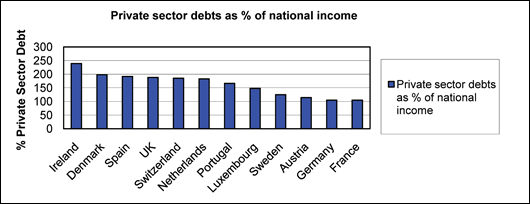
Ireland's private sector debts are higher than anywhere else in the EU.
Source: Drawn by Feasta from Central Bank data
As the money supply contracts, borrowers will have increasing difficulty getting the money together to service their loans. The banks' bad debts will soar and they will begin to make losses which reduce their capital base. This will mean that they either have to lend less or, if things get very bad, that they start calling in loans. Both courses would mean that there was even less money in circulation and that additional loans went bad. As every billion the banks lose means ten billion less they can lend, a frightening spiral of bad debts leading more bad debts would develop.
In order to stop the spiral, the government would have to make good the banks' losses by injecting capital. It would probably do so by buying new shares on very advantageous terms, borrowing the money to do so. The amount it might have to borrow could be substantial. The banks' riskiest loans are those to property developers and at the end of June, those outstanding in Ireland alone amounted to e86.7bn, 20 per cent higher than the previous year. This figure does not include loans made in Britain and elsewhere. It also excludes the accumulated interest which normally stays unpaid until developments are sold.
If half of the developers' loans have to be written off over the next two years, the state would have to borrow e45bn to inject into the banks. This would double the national debt. Some commentators put the banks' likely losses at less than this figure – analysts at JP Morgan estimate that e7.6bn will be needed while NCB Stockbrokers say e14.1bn - but e45bn is not unrealistic, particularly as other types of borrowing will turn sour too.
Injecting e45bn into the banks to make good their losses would be to pour it down the drain. All the money would do would be to prevent matters getting worse. The underlying problem that there was too little money in circulation for private debts to be repaid would stay unsolved. Consequently, it would be far better to use the money now to prevent as many as possible of the bad debts being incurred rather than to throw it away in a year's time to honour the guarantees, .
If the state is to have any hope of avoiding having its guarantees called it must get more money into people's bank accounts to spend, so that their spending gives at least some of the businesses which have borrowed the means to service their loans.
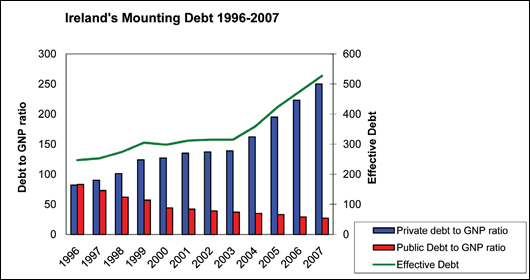
Graph 3: Ireland's national debt has shrunk in relation to its GNP since 1996 but itsprivate sector debt has grown to three times its level then. Because higher interestrates have to be paid on private debt and capital repayments have to be made, thisimposes a much heavier debt service burden on the country. By 2007, the debt serviceburden was twice what it had been ten years earlier.
Source: Drawn by Feasta from Central Bank data
Money gets into circulation, and thus into people's bank accounts, in three ways. One is that the country earns it by selling more goods and services outside Ireland than it imports. Unfortunately, that way will be closed off for at least the next two years as the country is running an e8bn a year deficit on its balance of payments current account and it is hard to see how this could be corrected in the time available. Indeed, that deficit, which has been exacerbated by high fossil fuel prices, reduces the amount of euro in circulation and thus increases the amount of money that has to be brought into the country by other means.
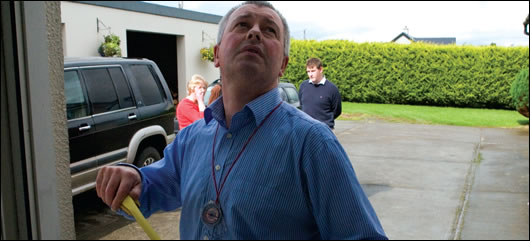
Energy assessor Stephen Harte, measuring a house in Tipperary during the Home Energy Saving scheme pilot
The second way to get more money into circulation is for foreign firms to invest here. I'll come back to that later. The third way is for us to borrow it. However, as we have already noted, Ireland is already over-borrowed. Should we really take on more debt? It would certainly be the height of folly to borrow to try to reflate the property market or to maintain current rates of consumption. Any new loans should be invested only in ways which bring down Ireland's demand for imports and thus free up enough money to allow the foreign portion of the borrowed money to be serviced and repaid. It is fortunate that only a fraction of the required loans would need to come from outside the country. Just as e1bn lost by a bank means that e10bn disappears from circulation, so an inflow of a billion from abroad creates an extra e10bn in deposits here. It also creates e9bn extra in debt owed to Irish residents.
The government is going to have to initiate this money-creation-by-lending cycle and since most of Ireland's energy is imported, Feasta suggests that the stimulation of projects which either reduce energy use or produce it from renewable resources should be its priority.
The scale on which it is going to have to borrow is substantial: For the economy to return to the condition it was in a year ago requires an increase in bank borrowing of around e50bn. The government could stimulate that extra borrowing if it borrowed e5bn itself (on top of whatever it is going to need to borrow anyway) and spent it wisely. This is less than the amount it would have to inject into the banks under even JP Morgan's optimistic forecast.
It should aim to stimulate borrowing at two levels, domestic and industrial. Let's take domestic first. A year ago, Minister for Energy Eamon Ryan told me of his plans to improve the energy efficiency of tens of thousands of houses. He was trying to work out a way in which a contractor could achieve economies of scale by working on most of the houses on an estate at the same time. “There might only be three or four house types” he said, “so it would be easy to work out what should be done and what it would cost.”
But how was the cost to be paid? Many householders would not wish to borrow to pay for the work. So I mentioned a technique used in England in which the loan required by a whole estate was taken out by the electricity supplier and its customers paid it off in installments added to their bill, which was, of course, lower, because of the efficiencies achieved. If a house was sold with some of the bill unpaid, the new owner took on the debt.
Since then, the government has made e5m available for work on improving housing in three areas – in Tipperary, Limerick and Dundalk – along with “clusters” of housing elsewhere in the country on a pilot basis. This will be completed by Christmas but the idea of enabling owners to pay through their energy bill appears to have been lost and getting people to participate was difficult. The Dublin energy agency CODEMA is also developing a cluster approach which it says has the potential to be scaled up.
The Construction Industry Federation says that over half of Ireland’s total housing stock of 1.6 million houses have a low energy rating as they were built before the Building Control Act was passed in 1990. It suggests that an average of e10,000 spent on each “would move them significantly up the energy efficiency scale.” This sum would, in their view, cover:
Filling cavity walls or dry lining or applying external insulation to outside walls
Insulating attics
Installing new double glazed windows
Installing new boilers and heating controls
Fitting weather strips
It is pressing the government to spend e225m each year for six years by offering a 15 per cent grant towards the cost of the work, which would be worth e9bn to the industry. It is compiling a register of companies to carry out the retrofits under a quality assurance scheme similar to Homebond and is trying to develop a loans scheme with the Irish Bankers' Federation.
It is obvious from the CIF's figures that improving 150,000 houses a year would not increase borrowing by anything like the required amount even if one worked with Sustainable Energy Ireland's cost estimate of e25,000 a house rather than the e10,000 one. Nevertheless, the work is well worth doing and the increased tax revenues and lower unemployment costs could easily save the State more money than it spends.

|
| Dr. Michael Walsh, CEO of the Irish Wind Energy Association |
But very much bigger schemes are needed and we have to turn to the industrial sector for those. Dr. Michael Walsh of the Irish Wind Energy Association says that a lot of borrowing and spending would be generated if more of the proposals for 8,000MW of wind energy capacity were able to proceed. “That's e16bn worth of projects. 70 per cent of the cost is the wind turbines and that would go out of the country, but 30 per cent is for site-works and other Irish expenses. That spending could start quite quickly as the turbines are the last things to go on the site.”
At the moment, windfarms with only 1,500MW capacity have been given the go-ahead and some of these are delayed by uncertainty over whether the banks will lend. In other cases, the planning permission has expired because the approval process took so long. “The minister has said that he wants to extend the planning period so that the farms do not have to apply again but this requires primary legislation. I think we can expect something in the Finance Act for this year's budget” Walsh says.
In a speech at the IWEA meeting in Belfast this October, the Energy Regulator, Michael Tutty, pointed out that “if all wind applications in the queue were built, capacity would be well beyond even the maximum demand on the island. Export can be the answer if interconnection and demand from abroad is adequate.”
Tenders to build Eirgrid's interconnector to Wales, which is due for completion in 2012, were submitted in June and a contract will be awarded by the end of the year. The project is on schedule. Attempts to contact Imera about progress on its interconnectors were unsuccessful but it is known that it does not have permission yet to link into the grids on each side of the Irish Sea. It is therefore possible that its first link will open late.
Besides the interconnectors, the grid will need to be strengthened before more wind energy can be allowed on to the network. Grid 25, a document proposing the spending of e4bn to enable the grid to carry 60 per cent more power, was published by Eirgrid on October 8 but the pace envisaged seems very leisurely as the work will be done between now and 2025. Moreover, its projections seem to cover only rising domestic demand and ignore exports. Very little detail is given of any new lines to be built and Michael Kelly, a company spokesman, admits that a lot of planning still has to be done.
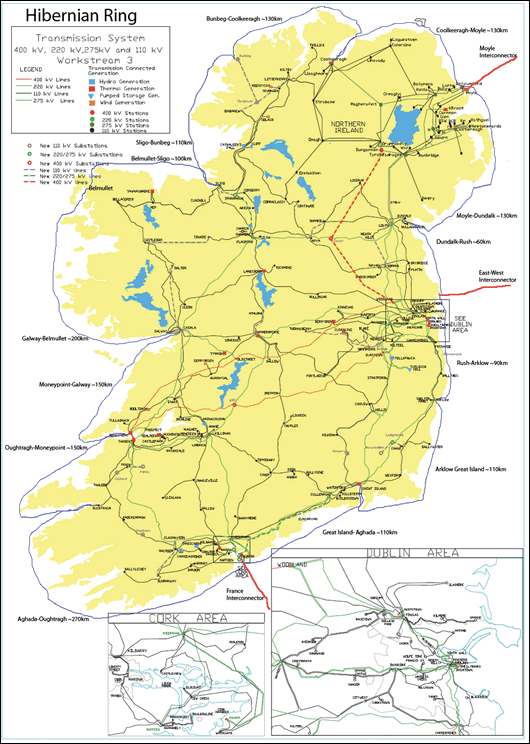
Grattan Healy’s concept, the “Hibernian Ring”, as shown by the blue line, could facilitate the carrying of power from marine sources to coastal cities
In particular, the grid needs to be strengthened between the west of the country, where many of the windfarms will be, and the east, where the power will either be consumed or be exported by the interconnectors. No plans have been published for these new lines and Michael Tutty thinks that there will be serious public protests when they are, whatever routes are chosen. Any such protests would be bound to cause delays even if planning consent was obtained under the Strategic Infrastructure Act.
A solution might be to run the lines underground but this would only be possible at reasonable cost if a high voltage direct current (HVDC) system was used, the same as the interconnectors. Indeed, if HVDC was adopted – and Michael Kelly says that it is being considered – the effect would be to extend the interconnectors to the west coast.
Grattan Healy, who is developing a 100MW offshore wind farm for the west coast, says that he hopes that it will be generating by 2015 but it could be in place much earlier than that if he could get the power away. “It's the grid that's setting the timing” he says.
His frustration over the delay has led him to think “out of the box”. He points out that there's almost nowhere on the Irish coast that does not have wind, wave and tidal power potential. What's needed, then, is a ring-main right around the island ready to connect all the projects up as soon as they are built and to carry their power to the coastal cities like Belfast, Cork and Dublin, as well as to Glasgow and other places down the British coast. This would be much better, he thinks, than gradually building lots of power lines across the country, and the total length of cable would be shorter in the end.
The “Hibernian Ring” as Healy called his “thought experiment” when he presented it at a workshop organised by the Commission for Energy Regulation in August, would certainly speed up the development of Ireland's marine energy sources. Moreover, building it now is likely to be cheaper in real terms than in ten years' time when fossil energy supplies will be restricted. “Even if there's no grand plan, most of the ring will be built on a piecemeal basis anyway as offshore resources are developed.” Healy says.
“It's a brilliant concept” says Michael Walsh of the IWEA. He adds, however, that the best way that the government could help the wind industry in the short term, would be to order Eirgrid to tell projects when a connection will be available. “What's needed is certainty” he says. “If you can be guaranteed a connection by 2012, then you could have your project in place by then.”
Even if the grid was fit to cope with a large number of windfarm connections, there would still be insufficient borrowing to prevent an economic decline. The problem is that we are trying to replace one type of construction which was running on a massive scale with another which is only just starting. Accordingly, the government is going to have to stimulate a lot of other energy-related areas to succeed in getting enough borrowing and spending flowing.
Its main aim when spending its borrowing should be to get money into circulation in the second way by establishing a cluster of energy product manufacturing companies here in the way that it has done with pharmaceuticals and computing. A combination of research and capital grants could be effective. Aside from the obvious areas of insulation, sustainable building materials and innovative heating systems, the IDA's shopping list could include firms making:
Smart meters: The Irish market is worth e600 million and one of the leading companies, Landis & Gyr is run by Cameron O'Reilly, Sir Antony's son. It is based in Switzerland.
Flow batteries: These enable large quantities of electricity to be stored. The leading firm is in Vancouver.
HVDC cable: The market leader is ABB, another Swiss company. This type of cable obviously needs to be made in a seaside location so that it can be loaded straight on to cable laying vessels.
Light trams: Parry People Movers might be induced to move from England. Its technology could be combined with that used in the Swiss-developed gyrobus so that the trams use electricity at each stop to store enough energy in their flywheels to carry them on to the next.
Wave power devices: The snake-like Pelamis device is currently the leading technology. The first commercial installation is in Portugal because the Portuguese government wants it to be made there.
Floating offshore platforms for wind turbines: The strongest winds are off the west coast but the water there is often too deep for the turbine tower to be mounted on the sea bed. Floating platforms are being developed. Ireland should lead this technology.
Electric cars: Under the Electric Transport Programme to be announced by Minister for Energy Eamon Ryan and Minister for Transport Noel Dempsey shortly, 10 per cent of the cars on Irish roads in 2020 will be electric. Several policymakers, including one from the ESB, have visited Israel and Denmark to see “better place” projects which involve the use of cars with swappable batteries. .
Environment Minister John Gormley's Carbon Budget speech on October 15 made it clear that he wanted to develop a cluster of firms in these areas. He said that the global market for green technologies was currently worth e284bn and he was setting up a high-level action group to advise government on its strategy within the next four months.
We must hope that the action group appreciates the need for a massive and speedy spending programme. It should also recognise that none of the projects it identifies will go ahead, even with generous grants, unless investors are convinced that energy costs will be high enough in future to make them worthwhile. The trouble is, now that the world economy is entering a depression, oil prices are falling. This is weakening the immediate incentive to save energy and to develop renewable sources.
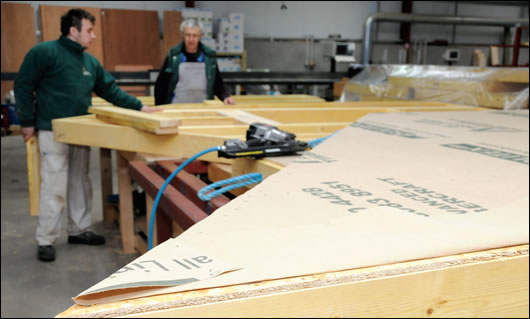
Ireland should look to manufacture technologies that combine low embodied energy with energy efficiency for end-users such as (above) ecological timber frame construction as exemplified by Newtownabbey’s Advanced Timber Craft; and (below, left and right)Parry People movers’ trams, which use gas or electricity to charge fly wheels and boost efficiency
The solution is to introduce Cap and Share (C&S)and use it to restrict the use of fossil fuels to such an extent that their Irish price is high whatever happens on world markets. This would provide, in essence, a feed-in tariff that rose each year for all types of renewable energy production and for energy saving. Another way of looking at C&S is that it imposes a declining annual quota on energy imports so that domestic energy production can develop to fill the gap. This would give borrowers/investors the security they need. As C&S is an essential part of any plan for a rapid transition to a low-carbon economy, a government announcement about it is expected shortly.
Seven points can be made about the borrowing strategy I've just proposed.
1. Any further fall in the money supply is likely to destroy the business confidence required for people to take on new loans. Action therefore needs to be taken urgently, particularly as there is only a limited amount of time before lenders begin to question the value of the state guarantee.
2. The prices of houses and other properties will still fall but a deep overshoot before they stabilise may be avoided. No attempt should be made to prevent the fall happening because property prices are out of line with incomes and forcing people to tie up extra money in unproductive assets would mean that they had less available for energy investment.
3. Because of the property price fall, some of the outstanding property debt will still go bad. However, if the banks can make money in other areas because of the new activity, the losses which the government has to bear will be reduced.
4. The energy investments made will put Ireland in a much better situation in relation to its climate obligations and give it increased energy security. They will also cut the costs of fuel imports.
5. The country will get a better balance between state and private borrowing. The state was borrowing indirectly during the property boom, collecting perhaps a third of the amount the private sector borrowed. It would have been better had it borrowed itself because the cost of servicing the loans would have been lower and no capital repayments would have had to be made. If the state now borrows itself in a way that enables private lending to fall as a proportion of total debt, the overall debt burden will be reduced.
6. The government should be far more concerned about getting enough money borrowed than ensuring that the borrowed money is well spent. It should weigh the losses that will result from rushed projects against the losses it will have to make good if the banking system collapses.
7. If the strategy fails and the state cannot prevent a banking system collapse which forces it to default itself, the financial consequences would be no worse than if the strategy had not been tried. The country's economy and infrastructure would, however, be in better shape.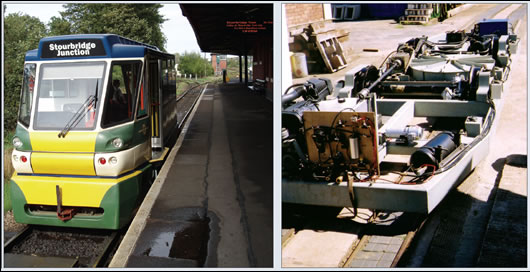
- Articles
- economy
- Sustainability or bust
- Economic
- Crisis
- property
- Boom
- Banking
- Collapse
- cap and share
- Cap
- Share
- Credit Crunch
Related items
-
 Green shoots for green building
Green shoots for green building -
 Banking on sustainability
Banking on sustainability -
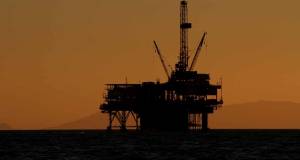 The world energy crisis 2022
The world energy crisis 2022 -
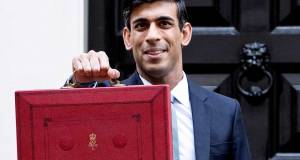 Green groups critical of latest budget
Green groups critical of latest budget -
 Passive house costs falling, new study finds
Passive house costs falling, new study finds -
 New Leeds developer goes passive
New Leeds developer goes passive -
 New property finance platform offers chance to invest in Dublin passive house
New property finance platform offers chance to invest in Dublin passive house -
 Green finance must be longterm & sustainable — Ecology
Green finance must be longterm & sustainable — Ecology -
 Why housing isn't viable
Why housing isn't viable -
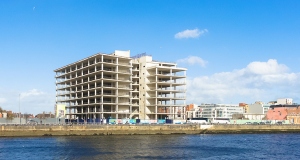 Irish construction industry has long opposition to higher standards
Irish construction industry has long opposition to higher standards -
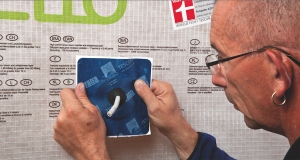 Free training in low energy building starts this month
Free training in low energy building starts this month -
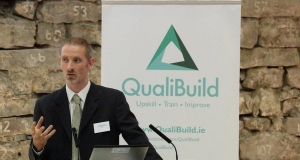 Conference hears of urgent need to upskill Irish construction workers
Conference hears of urgent need to upskill Irish construction workers

